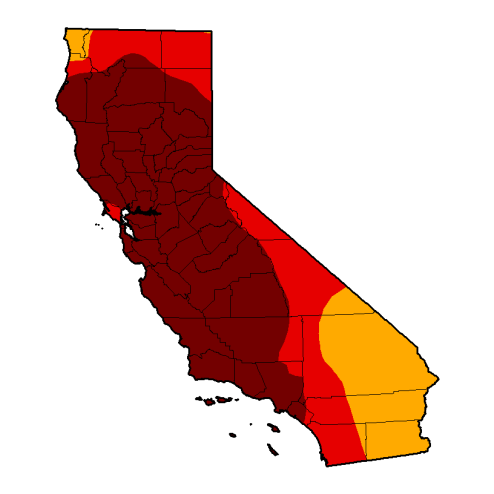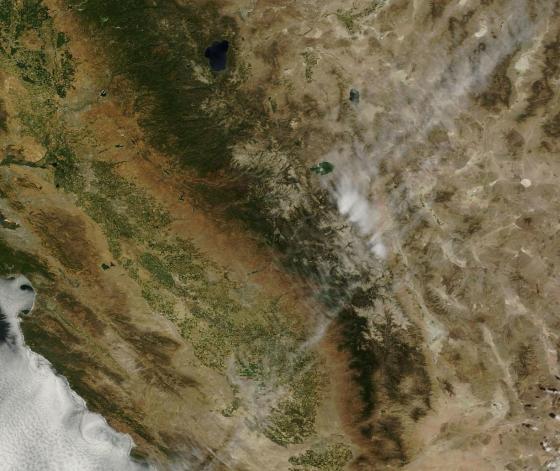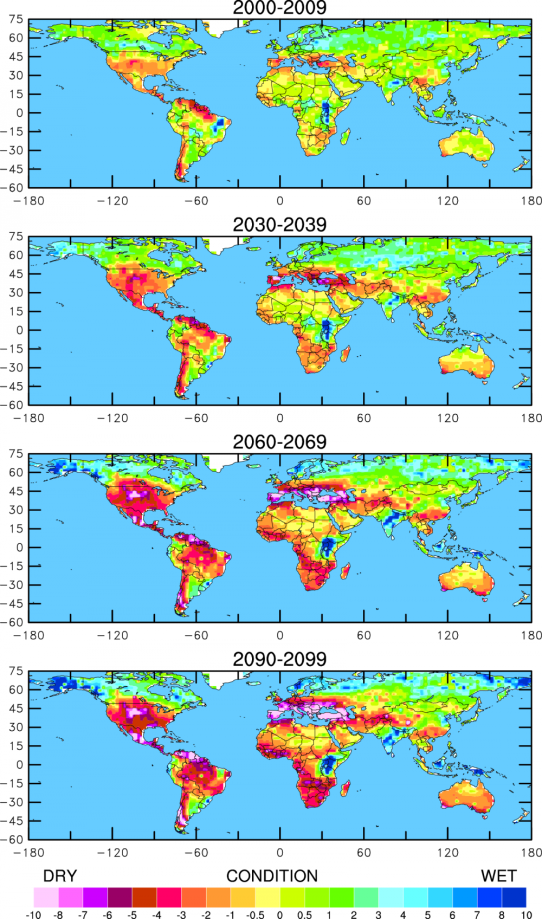For California, the punishment just won't stop.
Human warming and a climate change induced blocking pattern have withered California under record drought conditions for the better part of three years now. A vicious trend that worsened again in recent days with yet another jump in drought severity as exceptional drought conditions surged to cover a majority of the state.
Previous week's values of 36 percent exceptional drought coverage rocketed to 58 percent in just one week. Exceptional drought is the highest drought category for the US Drought Monitor, representing the most extreme conditions in the measure. So most of the state is now sweltering under the nation's worst drought category with the remainder covered by extreme and severe drought:
(
US Drought Monitor map of California showing 58 percent of the state covered in exceptional drought [brick red], 23 percent covered in extreme drought [red], and the rest covered in severe drought [orange]. California is now entering its fourth month of 100% drought coverage after more than three years of abnormally dry conditions.)
One hundred percent drought coverage with worsening conditions has been the prevailing pattern ever since May when drought first surged to blanket the entire state. Since that time, conditions have been steadily worsening with agricultural regions drying out, farmers, communities and industries forced to further deplete limited ground water supplies, and with reservoirs dropping despite best efforts by federal and state officials to conserve.
As a result, state supplies are being hammered. For, according to a report released today by the
National Drought Mitigation Center, the state is “short more than one year’s worth of reservoir water, or 11.6 million acre-feet, for this time of year.” In other words, if a year's worth of rain fell over the state tomorrow, it would barely be enough to bring reservoir levels back to normal.
So far, drought effects have been mitigated, mostly through the above-mentioned reliance on ground water supplies. But it remains questionable how long such activities can continue. And despite even these efforts thousands of agricultural workers have been laid off amidst a 2 billion dollar loss for the state's food industry.
As ground water and reservoir levels continue to drop, officials have grown more anxious to enforce conservation measures. To this point, fines in excess of 500 dollars have been levied for residents hosing sidewalks and driveways, for excessively watering their lawns, or for other water intensive practices. To this end, many municipalities have hired 'water police' to patrol neighborhoods and enforce water conservation measures.
Climate Change and A Mangled Jet Stream
(A Sierra Nevada mountain range featuring glaciers turned brown and sweltering under temperatures as high as 70 degrees on July 25, 2014. For 2013 to 2014, the Sierra Nevadas have been mostly devoid of the reservoir-restoring snows that California typically relies upon. Image source:
LANCE-MODIS.)
This more rapid heating of the far north has also resulted in a reduction of the north-south temperature differential. In the past, a high difference in temperature from north to south helped drive a prevailing wind pattern called the Jet Stream which kept weather systems moving across the Northern Hemisphere. But as the difference between north and south temperatures dropped, weather systems tended to stall. High amplitude waves tended to form in the Jet Stream and blocking patterns tended to emerge more often.
For California, the upshot has been the increasing prevalence of a ridge and blocking high pressure system deflecting storms away from the California coast. The pattern, which began to take hold three years ago, has been an almost constant feature for the past 16 months. And the result has been one of the worst droughts California has ever seen.
In May,
a new scientific study linked the anomalous blocking pattern, the California Drought and human caused climate change stating:
The 2013–2014 California drought was initiated by an anomalous high-amplitude ridge system. The anomalous ridge was investigated using reanalysis data and the Community Earth System Model (CESM). It was found that the ridge emerged from continual sources of Rossby wave energy in the western North Pacific starting in late summer and subsequently intensified into winter. The ridge generated a surge of wave energy downwind and deepened further the trough over the northeast U.S., forming a dipole. The dipole and associated circulation pattern is not linked directly with either El Niño–Southern Oscillation (ENSO) or Pacific Decadal Oscillation; instead, it is correlated with a type of ENSO precursor. The connection between the dipole and ENSO precursor has become stronger since the 1970s, and this is attributed to increased greenhouse gas loading as simulated by the CESM. (emphasis added)
Models Show Worsening Drought Conditions Under Human-Caused Climate Change
Unfortunately for California, the US Southwest, and for a growing portion of the country, the most recent drought may be just one in a string of many increasingly worsening events to come. Climate models predict a wholesale drying out of the US Southwest and Central US under an intensifying regime that has already begun to take hold. By mid-century conditions are expected to be quite extreme indeed:
(
NCAR model study of global precipitation under moderate warming throughout the 21st Century. The scale is based on the Palmer Drought Severity index with values of -4 and lower at exceptional drought. Under this model run, most of the US is blanketed by exceptional drought conditions. Overall, drought is expected to originate in the south and central US and then expand north and eastward as human caused warming intensifies.)
For Californians suffering under a three year long drought, such long-range forecasts indicate that the worst may be yet to come. For the short-to-middle-term, the west coast blocking pattern remains in place and shows little sign of movement. For the long-term, unless human greenhouse gas emissions are rapidly reduced, droughts of this intensity grow more and more likely.
But Californians are not alone, as model predictions show most of the US coming under an increasing regime of drought as human-caused warming intensifies throughout the 21st Century. Drought emerging now in the US Southwest is expected to expand north and eastward, eventually taking root and reaching an extreme intensity in the Central US. The front of drought then rides into the US Southeast and Mid-Atlantic as, by mid-to-late century, it surges northward into Canada.
The lesson to take from this is that few in the US are spared a fate of worsening drought spurred by human-caused climate change. And with climate change clearly linked to the California drought, we may be getting a bit of the bitter taste of what's still to come.
Links:




0 Comments:
Post a Comment
Subscribe to Post Comments [Atom]
<< Home